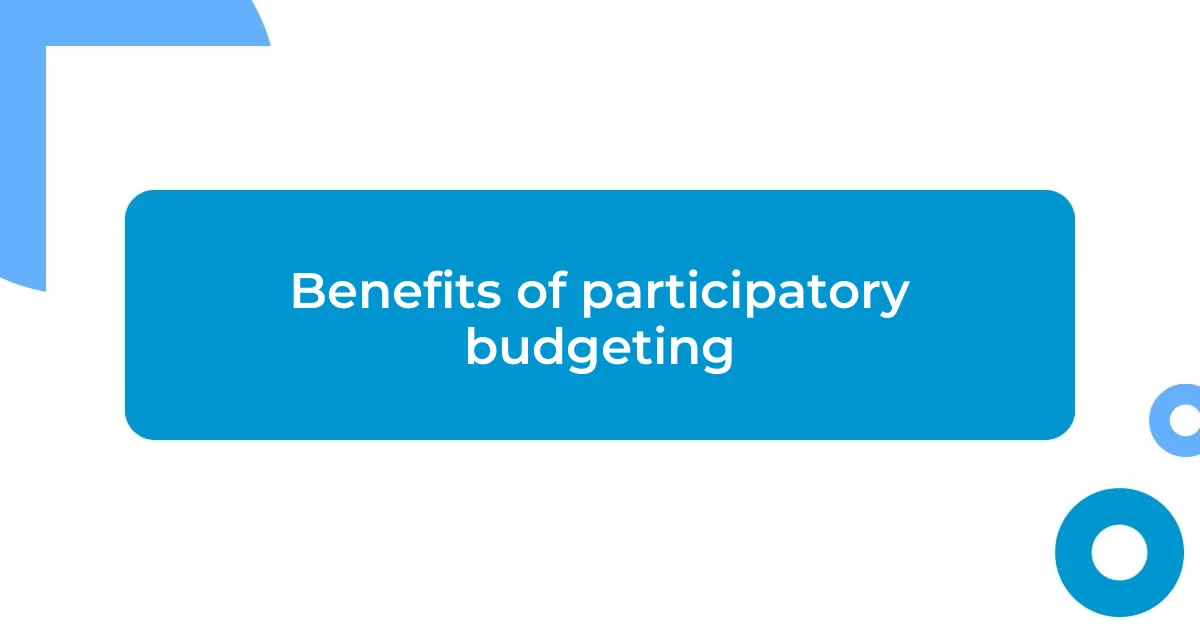Key takeaways:
- Participatory budgeting (PB) empowers communities by involving them in decision-making, fostering transparency and accountability in public fund allocation.
- Challenges such as differing priorities and limited understanding of budgeting concepts highlight the need for inclusivity and clear communication within the process.
- Active listening and patience are vital for effective outreach and building trust, ensuring that all voices are heard and valued in the budgeting process.

Understanding participatory budgeting
Participatory budgeting (PB) is a democratic process where community members come together to decide how to allocate part of a public budget. I remember the first time I participated in a PB event—it was exhilarating to see ordinary people, just like me, discussing and debating the best use of funds for our neighborhood. It made me realize how empowering it can feel to have a voice in the decision-making process.
At its core, participatory budgeting fosters transparency and accountability. I often wonder, why don’t more communities adopt this method? There’s something truly magical about watching ideas transform into actionable projects, rooted in the needs and desires of the people. Just think about it: citizens working collaboratively to bridge the gap between public funds and community aspirations.
Every time I engage in PB, I’m struck by the diversity of perspectives represented. It’s a vibrant tapestry of opinions and ideas, with everyone bringing their unique experiences to the table. That diversity not only enriches the decision-making process but also creates a sense of belonging. Participatory budgeting isn’t just about numbers; it’s about connecting with our neighbors and building a stronger community together.

Benefits of participatory budgeting
Participatory budgeting shines in its ability to foster civic engagement. I recall sitting alongside my neighbors, feeling the excitement buzz in the room as we hashed out what projects would benefit our area the most. Each voice mattered, and that sense of involvement and investment was palpable. The collaborative spirit energizes the community, encouraging individuals to care more about local issues.
Another significant advantage is how participatory budgeting promotes accountability and transparency in government spending. When I first witnessed the dramatic shift from politicians making decisions in closed rooms to seeing every proposed project laid out for community discussion, I was impressed. This process demystifies budgeting, letting citizens scrutinize and influence how funds are allocated. It transforms trust into action; the community feels like real stakeholders in public resources.
Notably, participatory budgeting can lead to a more equitable distribution of resources. I was genuinely moved to see voices from historically marginalized groups gaining visibility and weight in our discussions. This inclusion allows us to identify and prioritize projects that reflect the community’s true needs, leading to investments that impact lives profoundly. Every time I reflect on this, I believe more firmly in the potential of PB to create a more just society.
| Benefits | Description |
|---|---|
| Civic Engagement | Involves community members in decision-making, fostering a sense of involvement. |
| Accountability and Transparency | Government spending becomes clearer, allowing citizens to scrutinize and influence funding decisions. |
| Equitable Resource Distribution | Gives voice to marginalized communities, ensuring diverse needs are met in budget allocations. |

My journey into participatory budgeting
Embarking on my journey with participatory budgeting felt like stepping into a new realm of community connection. I can still see the brightly colored post-it notes we used in our brainstorming session, each one representing a dream project or solution. It wasn’t just about the proposed ideas; it was about the conversations that sparked new friendships and strengthened existing ties. We transformed a mundane budget discussion into a lively dialogue that underscored our collective hopes and dreams.
- The first event I attended filled me with a mix of nerves and excitement.
- I watched as my neighbors shared heartfelt stories about why certain projects mattered to them.
- There was laughter, even some tears, as we navigated the emotional stakes attached to budget priorities.
- Seeing how invested everyone was reminded me of the power of our voices combined.
As I dove deeper into participatory budgeting, I found myself increasingly passionate about the process. I remember being part of a small working group, tasked with reviewing project proposals. The sense of shared responsibility was palpable; we weren’t just evaluating budgets—we were nurturing community visions. It is fascinating how the act of deliberation brought our group closer, shedding light on values we didn’t know we had in common. This experience taught me that participatory budgeting goes beyond finance; it cultivates a culture of care and collective action.

Key methods for successful budgeting
When considering successful budgeting, one method that stands out is the use of community workshops. I vividly remember the first workshop I attended, where we gathered at a local community center. It was incredible to see the diversity of opinions as everyone shared what projects resonated with them the most. Issues that I wouldn’t have thought were pressing suddenly became apparent, and I found myself recalibrating my own perceptions of community priorities.
Another effective approach is to leverage technology for transparency and engagement. During a recent budget round, our team released an online platform where residents could track proposals, comment on ideas, and vote. I personally watched as individuals who might not have spoken up in a room felt empowered to type out their thoughts. It was a revelation to see how digital tools democratized the conversation, expanding the base of voices contributing to our collective decision-making.
Finally, embracing iterative feedback loops can greatly enhance budgeting methods. I recall our community’s approach where after each budgeting cycle, we would convene to gather insights and reflections. This practice not only improved our processes over time but also deepened our collective commitment. How else could we build on what worked and address what didn’t? It fostered a culture of continuous improvement that I believe is essential for any successful budgeting effort, making everyone feel more invested in outcomes.

Challenges faced during budgeting
The journey through budgeting isn’t always smooth; I encountered challenges that tested our resolve. During one particularly heated meeting, I remember a clash between differing priorities that felt both disheartening and energizing. It struck me how passion could veer into contention, leaving some participants feeling unheard. Have you ever felt that tension when diving into collaborative decision-making?
One significant hurdle was the limited understanding of budgeting concepts among some community members. I recall a session where the word “allocating” was met with blank stares. It reminded me just how crucial it is to ensure that everyone feels informed and confident sharing their opinions. It’s not simply about crunching numbers; it’s about creating an inclusive environment where everyone can grasp the process.
In retrospect, resource constraints came knocking at our door more than once. During our project proposal phase, several brilliant ideas had to be tabled because of financial limitations. I found it heartbreaking to see the spark in my neighbors’ eyes dim as we shifted to more feasible plans. How do we balance dreams with reality without compromising the enthusiasm that makes participatory budgeting so vibrant? This push and pull between aspirations and limitations kept me reflecting deeply on the essence of our community’s needs.

Tips for effective participation
Effective participation is all about fostering an inclusive atmosphere where every voice feels valued. I remember attending a meeting where we encouraged even the quietest members to share their thoughts by using small breakout groups. To my surprise, those groups led to some of the most insightful discussions, revealing diverse perspectives that enriched our final decisions. It’s fascinating how just a little encouragement can unlock such wisdom in the room.
Another important tip is to establish clear guidelines and expectations from the outset. In a particular session, we laid out what we hoped to accomplish and how everyone could contribute. By doing this, participants felt a sense of shared ownership over the process. It’s amazing how clarity can transform uncertainty into motivation. Have you ever noticed how focused discussions can yield more productive outcomes?
Lastly, I found that regular check-ins throughout the budgeting process helped maintain momentum and engagement. During one of our cycles, we scheduled quick follow-up chats between major meetings, allowing us to assess progress and celebrate small wins. These moments of connection not only kept us aligned but also strengthened relationships within the group. How often do we overlook those tiny yet powerful gestures that bond us and fuel our collective enthusiasm?

Lessons learned from my experience
As I reflect on my journey with participatory budgeting, one lesson stands out: the magic of active listening. There was a session where one participant shared a seemingly simple idea about improving local parks. I initially brushed it off as minor, but as we delved deeper, it unveiled community wishes that had long been buried. I realized how crucial it is to really hear people. Do you ever find yourself overlooking a gem because it’s hidden in the ordinary?
Another key takeaway was the importance of patience in outreach efforts. I vividly recall a time when we knocked on doors to involve more residents. It was exhausting, and responses varied from eager interest to outright indifference. Yet, each conversation taught me something new about our neighborhood’s heartbeat. Patience turned out to be my greatest ally—what we invest in community engagement often returns tenfold in understanding and collaboration.
Trust can be a delicate thing. I’ll never forget how one miscommunication during a planning phase left some individuals feeling sidelined, eroding what we had built. It was a hard lesson: transparency is non-negotiable. I learned to prioritize open dialogue and regular updates to fortify trust within the group. Have you ever seen trust migrate like that, needing constant nurturing? This experience taught me that a thriving participatory process hinges on building relationships—it’s the foundation upon which everything else rests.














